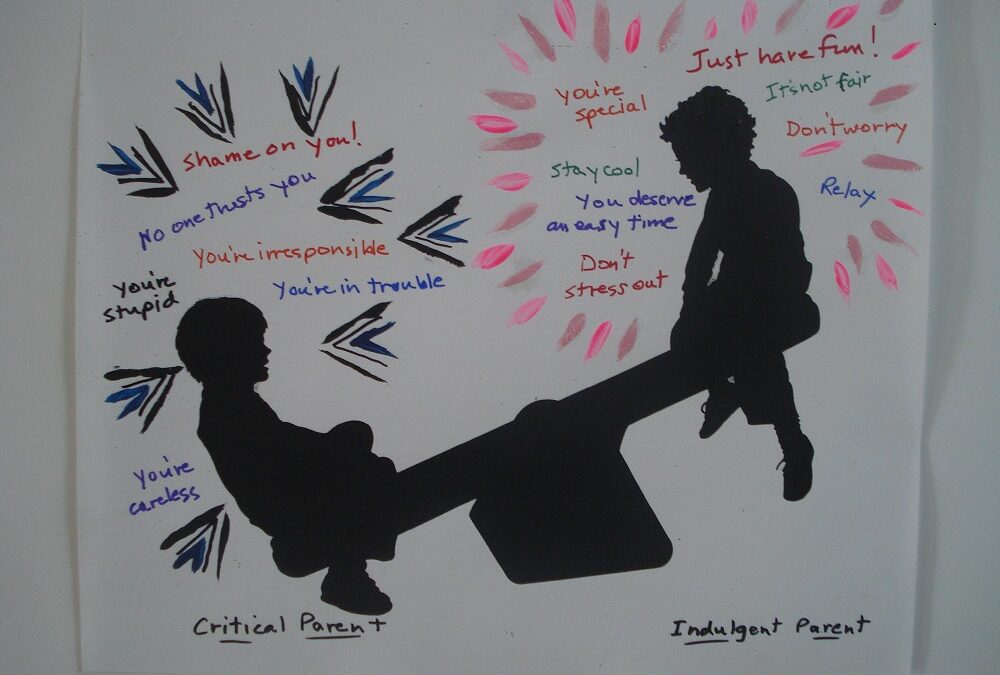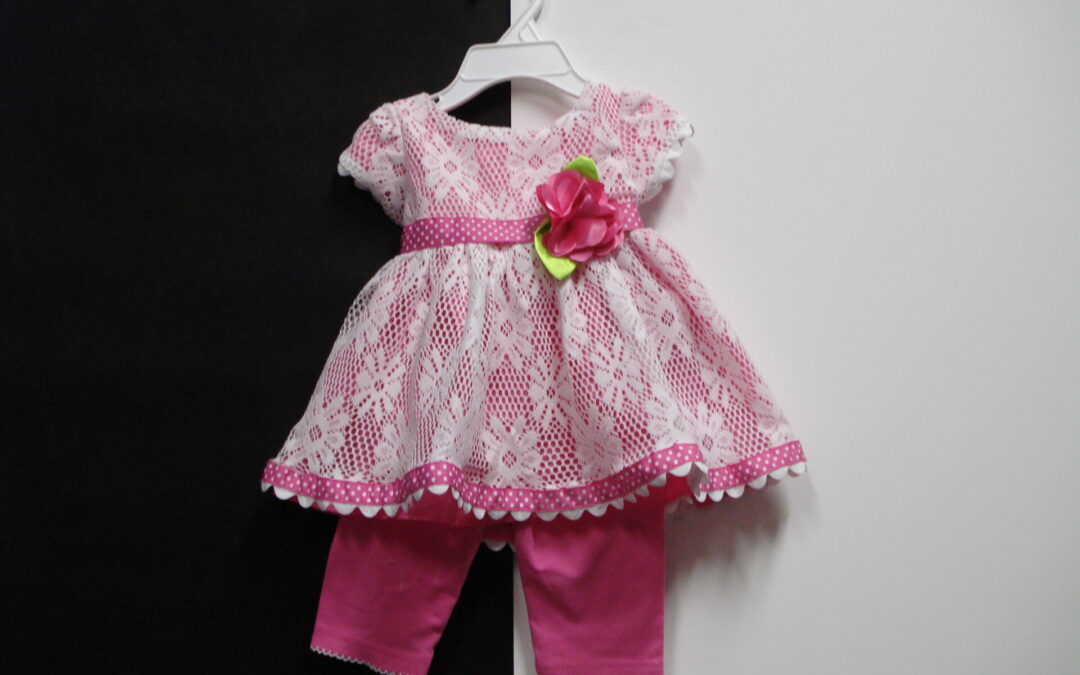
by wp-admin | Dec 9, 2021 | Exploring the Mental Fitness Formula
A see-saw of self-indulgence and self-punishment happens when you’re set up by your Indulgent Parent (IP). Your Critical Parent (CP) keeps you on a short leash so you can’t get into trouble, scolding your Child each time you fail to measure up to one of the six toxic beliefs your CP holds. Your Indulgent Parent soothes your child into a false sense of security as it supports the next six toxic beliefs.
Let’s take the example procrastination, Toxic Belief # 9, that it’s more comfortable to avoid than to face problems or responsibilities. This belief caters to your Child’s focus on present satisfaction rather than future security. Your Adult may caution, “Do I want the ice cream cone now, or the next-size-smaller pants in a month?” Then your Indulgent Parent whispers, “Oh, it won’t hurt to enjoy just this little treat. You deserve it. Why do today what you can put off until tomorrow?” Or you have a project for school or work that seems so difficult that you can feel your Child’s resistance in your gut. Your IP croons, “You don’t have to start that today; why not wait until you feel more up to it tomorrow?” It might add “It’s just not fair that they expect so much from you,” to encourage Belief # 11, that you’re special so you deserve an easier path.
A month later you’re still in the same size pants, your boss gives you a corrective action and your school project gets a failing grade. Your IP may still tell you it’s not fair or you don’t deserve such treatment, but your Critical Parent torments you for being lazy, irresponsible and lacking in character. Set up by your Indulgent Parent, you’ve traded future well-being for present comfort and your self-esteem has taken a hit. When this see-saw continues, it leads to decreased self-confidence, energy, hope and possible even to depression. Addiction is a frequent companion to this process, where your IP encourages using the drug-of-choice to gain temporary relief from the stress created by your failure to face problems or responsibilities. This process is described in detail in Part II, Chapter 2 of Claim Your Own Mental Fitness.
Your Adult must act with a firm hand to grab the see-saw and tell you to get off. It can identify Belief #9 along with any others involved. For example, your avoidance might have begun after you had a disappointing experience that prompted toxic belief #7, that it’s unbearable to work hard for something and not get it. Your IP may chime in to say, “you tried hard enough to (lose weight, get a promotion, get an A), so why keep trying?” Your Child’s Black and White thinking could prevent you from looking for new ways to cope: it’s fair or unfair, it’s easy or it’s too hard, you’re special or worthless.
Once you’re off the see-saw, and seated with a cool glass of water under a friendly tree, your Wise Parent (WP) could remind you that: 1. Black-and-white thinking traps you into quitting or avoiding, not creative problem solving. It’s better to consider how to cope in a different way. 2. When you put off doing something you have to do, you create low-level anxiety, not peace. You may also end up with additional problems that are even harder to manage. 3 It’s not unbearable if your aren’t rewarded each time you work hard for something; everyone has to learn how to deal with this sometime.
Your Adult can help you break up a task into bite-sized pieces Your Wise Parent can offer encouraging words like, “a journey of a thousand miles begins with a single step” or “remember when you did this well before and how you got there.”

by wp-admin | Dec 9, 2021 | Exploring the Mental Fitness Formula
Imagine the shadow in this picture is my Adult and the very subtle pattern in the rivulet represents my three Child Brain Habits. It’s not easy to step out and take a picture of what happens in your brain. Let’s try to help you get a picture of these brain habits to help your Adult catch them at work.
To reach mental fitness your Adult needs all the help it can get to manage your own fight-or-flight reactions and then try to cope with the people and activities in your life. When it knows what to expect from your mind it can do this better. It’s pretty easy for your Adult to recognize a toxic belief and the Parent laying it on your Child, especially when you’ve learned what the most common beliefs are. Your Child’s plunge into fight-or-flight can be felt in your body and almost heard in its usual complaints of I can’t stand it and this is unbearable. Your Child Brain Habits are more difficult to identify and overcome.
These deeply imbedded ancient brain habits must have been helpful during times when our Adults had to recognize threats very quickly for survival. Speed must have been more important than accuracy then. I’ve named them Child Brain Habits because young children’s smaller, immature brains naturally use them to interpret what’s happening. They are: black-and-white thinking, personalization and over-generalization. When your Adult learns to catch them quickly, it can head off a whole lot of drama at its root.
These three brain habits share many of the same characteristics:
1) Since they’re evident in very young children and other mammals, they were probably wired-in for our protection early in human evolution.
2) They persist throughout your life, despite Adult efforts to retrain your mind.
3) Each one can have a broader impact on you than a toxic belief.
4) They each lead your Adult in a direction that sabotages it.
5) Since they’re constantly available, they appear in many situations without being noticed.
6) Each one influences you in more than one way, making it harder to identify and overcome it.
7) They set off many of your Toxic Beliefs, which can’t be permanently revised without also combatting the underlying brain habit.
8) Often more than one brain habit occurs at a time.
You can practice recognizing these habits in yourself, but it’s fascinating to see them play out among others. They’re pervasive in political discussion, religious theory, committee interactions and any time people come together. It’s helpful practice for your Adult to look for them when you’re not involved, on television or in movies or when just listening to others. These habits are deceptively simple and even those with the strongest Adult can fall under their influence.
It can be depressing to recognize how really fragile our human grip on reality is while you see people embrace these habits with passion and conviction. At a certain point, however, it’s refreshing to have your Wise Parent help you keep your perspective. To build this Parent’s wisdom, it’s fun to find wise quotes from others who have found ways to handle these primitive traits in your human nature. Sometimes you’ll even find yourself laughing at how absurd it can get, even for yourself.

by wp-admin | Dec 9, 2021 | Exploring the Mental Fitness Formula
First we’ll look at black & white thinking, the simplest and easiest Child Brain Habit to defuse. It prompts you to automatically sort all you see, hear and feel into polarities: black or white, right or wrong, loving or rejecting, trustworthy or unreliable, bad or good, okay or not okay, etc. As you follow this discussion, you’ll notice that this habit operates in different directions, when people use it for themselves and when it impacts how they relate to others. .
Let’s look at the example of three-year-old “Sherry,”* who was brought in for counseling after she had tried to throw herself out of the family’s moving car three times. Sherry’s parents had divorced six months earlier and claimed to get along pretty well. However, Sherry felt that she had to choose between them, and that was devastating for her. Relying on her black & white approach, she felt pressed to decide which parent was good and which one was bad. It seemed that no amount of reassurance could help her understand that she didn’t have to choose. I struggled with how I could reach her three-year-old mind to guide her out of this black-and-white trap.
Sherry always came dressed in pink and said it was her very favorite color. I asked her if she would change her mind and stop loving pink if her mom, dad or some of their friends didn’t like pink. Thoughtfully, she shook her head “no” as she considered this. I said the same goes for her feeling about each of her parents; she can love both of them, even if someone else doesn’t. She was able to use this pink bridge to overcome, at least for this problem, her habit of seeing things in black & white with no other options.
This polarized way of sorting experience can prevail throughout your life. But once your brain matures, you’re capable of managing this tendency on your own. Your Adult must monitor for this habit along with the other triggers for fight-or-flight. You wouldn’t flee by jumping out into traffic, but even in less disturbing situations than Sherry’s, black & white thinking can leave you distressed.
Note how this either-or view can intensify each of the first three Toxic Beliefs: Belief #1, If I don’t have x’s approval, I’ll be devastated. Belief #2, If I don’t get this (promotion, recognition) I’m a failure. Belief #3, If I don’t get this done, I’m bad (irresponsible, selfish, careless) and I deserve to have people blame and punish me. The habit affects how you believe others see you and how you see yourself. You’ll also tend to apply it when you see another person make a mistake and judge her same way you judge yourself, or worse.
The Child in the person you judge or your own Child might trigger fight-or-flight by thinking, that’s unfair, I can’t take this, or similar phrases and leave one of you very upset. Sherry felt that if she had to find one of her parents bad, selfish, weak or uncaring it was unbearable and she sought flight. Her black & white thinking intensified how she interpreted her toxic beliefs and it can do that with yours as well. Once your Adult can recognize a brain habit’s influence, it can reduce its impact, making your toxic beliefs more open to revision.
When you recognize that someone else may be caught up in black & white thinking, your Adult can avoid joining them. If it’s one of your friends, you may be able to invite them to take a break and cool off before they continue the conversation. This is an easy habit to shut down. Just remind them of some exceptions that illustrate the gray areas. For example, if someone says, “I just don’t trust him,” suggest that they might be able to trust him to be on time, or pay his bill at lunch, even if he is less than discreet. Help him see that trust isn’t an either-or condition; it’s multi-faceted. The same goes for any other polarized view.
You must avoid feeling stupid (as opposed to wise) when you see that you’ve backed yourself, or someone else, into a corner with this inherited way of thinking. It’s not your fault that once upon a time our ancestors needed to react this way to survive. They may not have had the time to consider any other options. Your Adult can begin to find and use Wise Parent reminder phrases to help you cut through a brain habit’s influence: There’s no immediate threat, I can take my time to check out my options: There’s no tiger in sight, I can wait and think about this. And a brief word for your Child, like, We’re safe, no worries.
*All names in these post stories are fictional.

by wp-admin | Jan 3, 2016 | Exploring the Mental Fitness Formula


In post 16, “Brain Differences and Fight-or-Flight,” I discussed how some people, whose wiring is significantly different from average, struggle harder to keep their Adult in charge. Now I’d like to describe how we, who are troubled by our differences, must resolve our grief over them to stabilize our Adult long-term. We must fortify our Wise Parent to be even stronger than average to avoid damaging shame, anger, anxiety and depression. We need to find within and outside ourselves sheltering branches, like those in the rock family picture, to comfort us as we try to cope. I’ll use my journey with this as a Highly Sensitive Person (HSP) to illustrate.
I knew I had to work harder by age ten because of my social anxiety and awkwardness. I also disliked how I could get easily annoyed by small things and very upset over any teasing. By age twelve I was studying Benjamin Franklin’s diary, where he tracked about a dozen behaviors for self-improvement. He noted that, as his score improved in the other areas, his humility score decreased. After reading Dale Carnegie’s How to win Friends and Influence People, I kept notes daily on how well I listened to others and refrained from sharing much about myself. I remained very closed off, except with one or two friends, until I went to college. I’ve seen many HSP clients who never tried again to engage with groups socially after junior high. (See hsperson.com with Elaine Aron.)
Until my first marriage failed at age 27, I didn’t have much non-work social contact due to my need to study hard in college and work many hours a day after that. At that point I received an assistantship for my Ph.D. program in Counseling Psychology. Over-reacting to my divorce, I was wracked with relentless insomnia and panic attacks. I grabbed every idea from my course work that I could about how to heal myself, for my own survival and so I could be a good mother to my two-year-old son. I didn’t accept the valium I was offered. The horrible panic attacks proved a gift for my healing and my ability to help others. I practiced the cognitive therapy and intense self-observation I learned in my classes day and night. I discovered exactly what self-talk and circumstances would set off or shut down a panic attack, and got over them in five years. The insomnia persists whenever I take on too much in my life or let even a minor social interaction disturb me. I still resent that.
I discovered that saying punishing things to myself out of frustration with my HSP wiring (now identified as sensory processing sensitivity) only provoked more anger, anxiety and panic. I learned to be gentle with my Child just to stay out of fight-or-flight. I realized this positive approach, and not the negative confrontations popular then, would also be most helpful to clients. I had to revise especially my Critical Parent’s toxic beliefs to sustain this approach and build a strong Wise Parent. To do this on a stable basis, I had to complete my grief process over the HSP brain I was dealt, long before the HSP trait was identified. I knew I wasn’t just suffering from the divorce trauma; I’d always been too anxious and hyper-sensitive. Denial, anger, and sadness over how I was different all had to be fully processed for me to reach self-acceptance.
Of course, many others have brain differences which cause them much more pain and limit them worse than being an HSP. But somehow they must also find a way to accept themselves in order to enjoy the gifts they do have, especially when others judge and blame them. Temple Grandin has done a heroic job of this with autism, but we can’t all manage that. If we just grow our Wise Parent’s sheltering branch inside and find the environment that supports us, we can each thrive in our own way. Compared to those with schizophrenia, severe bipolar disorder or other major impairments to their Adult functioning, my struggles are nothing.
It’s crucial that individuals and society stop indulging their biases against people who are mentally different in crippling ways. Worldwide mental health services are poorly funded and inadequate. It’s not true that everyone is born and raised to be equally capable of managing life. It’s the worst expression of our primitive human nature to shun them and leave them to suffer. We don’t have to do that to survive like our distant ancestors may have. These people deserve the deepest compassion and steadiest, wisest support from us fellow humans to help them be kind to themselves while they search for ways to join in.






